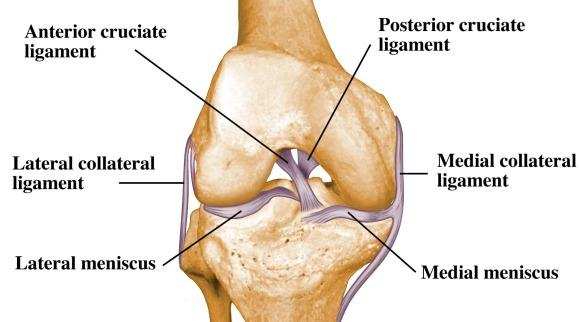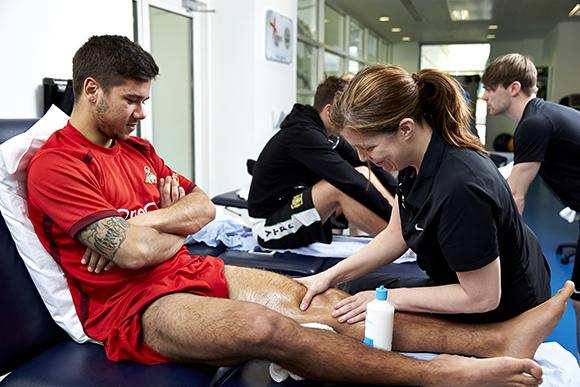Slide

Phair, Yasmin S. and Miller, Paul K. (2015) Inhibition of pain during the rehabilitation of knee ligament injuries: an interpretive phenomenological analysis. In: BASES Student Conference, 31 March - 1 April 2015, Liverpool John Moore's University, UK.
Usage of any items from the University of Cumbria Repository ‘Insight' must conform to the following fair usage guidelines:
Any item and its associated metadata held in the University of Cumbria Institutional Repository (unless stated otherwise on the metadata record) may be copied, displayed or performed, and stored in line with the JISC fair dealing guidelines (available at: for educational and not-for-profit activities
• the authors, title and full bibliographic details of the item are cited clearly when any partof the work is referred to verbally or in the written form a hyperlink/URL to the originalRepository record of that item is included in any citations of the work
• the content is not changed in any way
• all files required for usage of the item are kept together with the main item file.
• sell any part of an item
• refer to any part of an item without citation
• amend any item or contextualise it in a way that will impugn the author/creator/contributor'sreputation
• remove or alter the copyright statement on an item.
The full policy can be found at alternatively contact the University of Cumbria Repository Editor by emaili



Inhibition of pain during the rehabilitation of knee ligament
injuries: an interpretive phenomenological analysis.
Yasmin S Phair and Dr. Paul K Miller
University of Cumbria, Faculty of Health and Wellbeing, Sport and Physical Activity, Lancaster, UK
Introduction: In the UK, on average, 1-1.5 million people per year are use Accident and Emergency services as a result of injuries
sustained during sporting participation (Boyce and Quigley, 2004). Many of these admissions reveal long-term injuries requiring
extensive rehabilitative work. Much research in the broader rehabilitation domain has emphasised a strong link between individual
psychology and pain management during such processes. Indeed, it has been noted that as many as 80% of amputees still
experience – and therefore have to manage - pain in limbs that are no longer neurologically attached to the body (Davidson et al.,
2010.). The bulk of pain-related literature in the specific area of sport rehabilitation, however, remains strongly anchored to
physiological questions and solutions, with psychological investigations (and particularly qualitative variants thereof) in a distinct
minority. Concerns from Sport Injury Rehabilitation Professionals (SIRP) have also been raised that they feel inadequately trained
in order to deal with the psychological distress associate with injury (Stiller-Ostrowski et al. 2010).
Methodology: This paper, using Interpretative Phenomenological Analysis, reports qualitative findings on experiences of pain,
strategies for pain management, and how these interact with an injury rehabilitation process among a purposive sample of five
male amateur soccer players, aged 20-60 years old, from the North West of England.
Superordinate theme
Subordinate themes
Results: Rhythm of life
Bargaining
Age (maturity, immaturity)
Acceptance &
Depression
Coping mechanism
Learnt experience
Self distraction
Table 1: Themes established from interviews. Diagram 1: Five stage grief process (Kübler-Ross, 2005)
Discussion: Participants highlighted, during the recovery process, many nuanced difficulties in accepting and accommodating with
their pain experiences, and corollary physical restrictions and limitations. It was suggested by some that they may have benefitted
from being more supported psychologically, but it was also evident that greater maturity, life experience and responsibility, which
might typically be associated with positive outcomes for the recovery experience, could actually hinder as well as help. Athletes are
more likely to experience fear of re-injury as a result of mentally compartmentalising the injury, appose to addressing. Athletes at
times believe that SIRPs should know exactly what the athlete is thinking without the athlete themselves discussing any
psychological difficulties (Tripp et al. 2011). Furthermore if SIRPs administered psychological support through subtle goal setting, it
seems to have a much more positive affect, however the emphasis appears to be on the term ‘subtle' psychological support (Tripp
et al. 2011). It was also found that the amount of support an athlete may require or accept during recovery was heavily dependant
on what stage they were at in terms of acceptance of their injury, as well as life experience and personal situations. Previous
research by Kübler-Ross (2005) suggested that it is when patients are stuck in the ‘Denial – Anger' phase that this fear of re-injury
is rises, once again increasing the potential chance of re-injury (see diagram 1). Similarly, Clement et al. (2015) also found that the
level psychosocial support varied and who the support network was, as the injury recovery progressed.
Conclusion: It is proposed that this research answers some practice-focused questions and raises others regarding (a) the extent
to which and (b) the manner in which pain might psychologically impact upon injury recovery, and for whom. As a result enabling
SIRPs to be trained and better equipped to diagnosing psychological distress and supporting athletes through the recovery
process, thus improving the quality of care athletes receive, and reducing the time away from sport.
References
Boyce, S. H. & Quigley, M. A., 2004. Review of sports injuries presenting to an accident and emergency department. Emergency Medical Journal, Volume 21, pp. 704-706.
Clement, D., Arvinen-Barrow, M. & Fetty, T., 2015. Psychosocial responses during different phases of sport injury rehabilitation: A qualitative study. Journal of Athletic Training, 50(1), pp. 95-104.
Davidson, J. H., Khor, K. E. & Jones, L. E., 2010. A cross sectional study of post amputation pain in upper and lower limb amputees, experience of a tertiary referral amputee clinic. Disability and Rehabilitation, 32(22), pp. 1855-
1862.
Kübler-Ross, E. (2005) On Grief and Grieving: Finding the Meaning of Grief Through the Five Stages of Loss, Simon & Schuster Ltd
Stiller-Ostrowski, J. L. & Hamson-Utley, J. J., 2010. Athletic trainer's educational satisfaction and technique use within the psychosocial intervention and referral conent area. Athlete Training Education Journal, 5(1), pp. 4-11.
Tripp, D. A., Ebel-lam, A., Birchard, J., Stanish, W., and Brewer. B. W., 2011. Fear of re-injury, negative affect, and catastrophizing predicting return to sport in recreational athletes with anterior cruciate ligament injuries at 1 year
post surgery. Sport, Exercise and Performance Psychology, 1, pp.38-48
Source: http://insight.cumbria.ac.uk/2398/1/YSP%20%26%20PKM%20(2015)%20-%20Pain%20Inhibition%20-%20BASES.pdf
Postgrad Med J 2007;83:469–472. doi: 10.1136/pgmj.2006.055913 The diagnostic approach to ureteric colic has changed due to ultrasound, intravenous urography and computed the introduction of new radiological imaging such as non- contrast CT. The role of intravenous urography, which is Plain radiograph of the kidney, ureter and regarded as the gold standard for the diagnosis of ureteric
14 November 2007 Smoking and Mental Illness: Costs Report by Access Economics Pty Limited for Smoking and Mental Illness: Costs CONTENTS Executive summary.i Background .1 1.1 Efforts to combat smoking .9 Smoking epidemiology .11 Smoking aetiology .13 Smoking mortality .14 Mental illness .16 Mental illness and suicide .19




